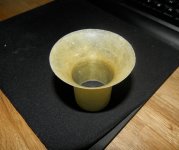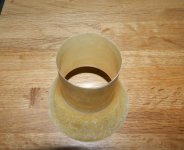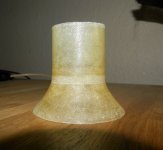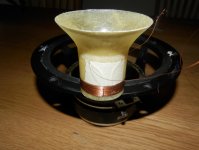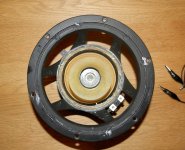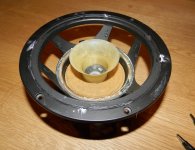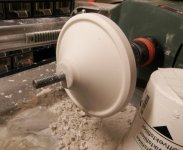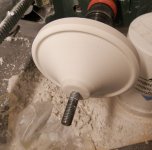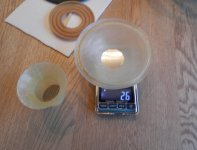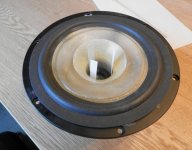Here is a update on the wizzer/voice coil former. It went pretty well, it is durable for sure but for now I need to make a former a each wizzer. Hentai, I can try to make one with paper for you, but what kind of paper do you want to use.
Attachments
Hi Hentai
I am sorry to say that I had no luck in making a wizzer with paper, I only had silkpapaer so that is what I used. But I think if you are going to use paper it is best to use a positive and a negative form, under high pressure.
The weight is 3.8 gr with the voice coil. I did a quick test and it relay works...There is plenty of energy in the high frequency range, a super tweeter for real. My guess is that it start a around 4-5KHz and up, but this is just by judgeing by ear.
Here is some pic's:
I am sorry to say that I had no luck in making a wizzer with paper, I only had silkpapaer so that is what I used. But I think if you are going to use paper it is best to use a positive and a negative form, under high pressure.
The weight is 3.8 gr with the voice coil. I did a quick test and it relay works...There is plenty of energy in the high frequency range, a super tweeter for real. My guess is that it start a around 4-5KHz and up, but this is just by judgeing by ear.
Here is some pic's:
Attachments
Hi Hentai,
Sure I can make a pair of wizzers for you. But sense you have access to Machinery, the best way is if you make a former and send it to me. You can make it of any kind of hard plastic or even hard wood, and if you make it your self, you decide the dimensions. On the other hand... if you like I can show you in more details how I make them, the hard point is to make the formers when you don't have the prober machinery. Once you have the former, there is relay nothing to it.
Sure I can make a pair of wizzers for you. But sense you have access to Machinery, the best way is if you make a former and send it to me. You can make it of any kind of hard plastic or even hard wood, and if you make it your self, you decide the dimensions. On the other hand... if you like I can show you in more details how I make them, the hard point is to make the formers when you don't have the prober machinery. Once you have the former, there is relay nothing to it.
For regular enamelled wire, check transformer winding supply houses.
Be CERTAIN to get "high temperature"wire, if possible "Class F/170 degrees Celsius" because nowadays thin wires often come in weak self fluxing enamel, which is designed to *evaporate* when hot.
VERY bad in a VC.
Be CERTAIN to get "high temperature"wire, if possible "Class F/170 degrees Celsius" because nowadays thin wires often come in weak self fluxing enamel, which is designed to *evaporate* when hot.
VERY bad in a VC.
Speaker Replacement Parts - MAT Electronics
Here is some spiders and voicecoils.It seems you have to cut the hole to the right size for the voicecoil yourself.
Bernt
Here is some spiders and voicecoils.It seems you have to cut the hole to the right size for the voicecoil yourself.
Bernt
Voice coil clearance?
Question for Hentai and JMFahey, need data for another thread and you have experience!
A typically voice coil and former is about 1.2mm thick I think?
How much clearance do you allow to the pole piece?
Radial space of 1.5mm = 1.2 + .15 x 2 would be reasonable?
Best wishes
David
Question for Hentai and JMFahey, need data for another thread and you have experience!
A typically voice coil and former is about 1.2mm thick I think?
How much clearance do you allow to the pole piece?
Radial space of 1.5mm = 1.2 + .15 x 2 would be reasonable?
Best wishes
David
Last edited:
Hi Hentai,
Sure I can make a pair of wizzers for you. But sense you have access to Machinery, the best way is if you make a former and send it to me. You can make it of any kind of hard plastic or even hard wood, and if you make it your self, you decide the dimensions. On the other hand... if you like I can show you in more details how I make them, the hard point is to make the formers when you don't have the prober machinery. Once you have the former, there is relay nothing to it.
Hi Frank, yes i will look into it, just thought you wanna develop your idea.
I apologize for intruding.
But where do you find a suitable selection of wire for VC?
Very nice thread btw! Best I've seen for ages!
Hello KaffiMann,
It really depends on what kind of wire you need. Copper wire is pretty easy to find, you should look at shops that wind transformers or do electrical motor repairs.
For aluminum or copper clad aluminum wire i only found in China and had to bring it in.
For regular enamelled wire, check transformer winding supply houses.
Be CERTAIN to get "high temperature"wire, if possible "Class F/170 degrees Celsius" because nowadays thin wires often come in weak self fluxing enamel, which is designed to *evaporate* when hot.
VERY bad in a VC.
a good point
I some one help me. I need a large spider for a 35.5mm voice coil but I can't find a dealer, I would like to finde one at around 120 to 150 mm.
Have you find the spider, i might be able to help in this regard.
Question for Hentai and JMFahey, need data for another thread and you have experience!
A typically voice coil and former is about 1.2mm thick I think?
How much clearance do you allow to the pole piece?
Radial space of 1.5mm = 1.2 + .15 x 2 would be reasonable?
Best wishes
David
Hi David,
It depends on many things and what you try to achieve. 1.2mm VC thickness is pretty thick for a fullranger but ok for a woofer and could be thin compared to some subwoofers.
a space of .15 between VC and polepiece can be pretty tricky and will give you lots of pain to avoid rubbing. Again considering the thickness of VC i imagine it can eat up some power and you need to consider the increase in thickness once it starts to heat up.
Can't give a "generic" answer, it depends a lot , as noted above, on what kind of speaker we are talking about.Question for Hentai and JMFahey, need data for another thread and you have experience!
A typically voice coil and former is about 1.2mm thick I think?
How much clearance do you allow to the pole piece?
Radial space of 1.5mm = 1.2 + .15 x 2 would be reasonable?
Split your problem:
1) typical former material is around 0.1mm (forget Inches here, not precise enough)
A tweeter might use 0.08mm and a ridiculous "1000W" car woofer might use ,say, 0.15mm
2) For initial calculation: wire is wire, whatever you actually measure is true.
Add 0.1 to 0.2 mm total (not per layer) to account for adhesive and/or some small winding imperfection.
Anyway: as soon as you have your sample VC, measure it.
Still add 0.1 to 0.15 mm to account for imperfections, tiny bubbles in epoxy, etc.
3) minimum "inside" clearance is 0.125 mm , that's what I use for my guitar speakers .
In a midrange or tweeter you *might* use 0.1mm .
3) On the "outside" you will need minimum same as inside, but in production stuff it's common to raise it to 0.2mm and even 0.25mm.
Why?.
Because on the inside you have the centering shim which "sweeps clean" that space so any dust spot will be pushed or cleared away; any "invisible" dust or whatever particle in the outside space will not, and give you headaches.
Unless you work in a guaranteed dust free room.
It also accounts for the VC expanding under heat (something many ignore)
These measurements are a reasonable compromise between efficiency and real World production.
JBL and others work with tighter tolerances because they can; typical cheap Chinese speakers (or Car speakers) show impressive frames and magnets, but use huge gaps (invisible to the customer) which waste most of the magnet energy.
Even JBL had to "open up" the gaps in speakers made for Fender, go figure.
NOTE: also consider the metal parts paint thickness.
Typical oven cured Epoxy or powder coat is *very* thick, I hate it.
I zinc plate all magnetic structure parts because it's thin and strong.
Last edited:
As a practice i tend to center the voicecoil in the gap as in the same distance for inner and outer clearings. I also go with inside outside winding to keep it as symmetrical as possible and a smooth BL curve altho you might get a slight increase in B value close to the pole piece. Also no problems when dealing with T shaped polepieces.
Also one needs to consider if copper rings are added in the gap.
Also one needs to consider if copper rings are added in the gap.
Hi there
Dave Zan, I measured the air gap on the two different I took apart they were 1.5mm. Since I am using ties magnet for starters , that is what I will be using.
Hentai, Thanks.... But I did placed an order now, and they had a min. purchase of 25$ so I got a variety of sizes.
I did make a new former for a 6,5” without wizzer, I want to se if it will work whiteout the wizzer. If it doesn’t I have the former to make a wizzer. Also I am trying to copy the former using liquid latex, but it is to early to say if it will work.
Just a note: I did get a normal voice coil and the weight of it is 6.5g.
Here is some pic's of the new former. The former is slightly modified now.
Take care
Dave Zan, I measured the air gap on the two different I took apart they were 1.5mm. Since I am using ties magnet for starters , that is what I will be using.
Hentai, Thanks.... But I did placed an order now, and they had a min. purchase of 25$ so I got a variety of sizes.
I did make a new former for a 6,5” without wizzer, I want to se if it will work whiteout the wizzer. If it doesn’t I have the former to make a wizzer. Also I am trying to copy the former using liquid latex, but it is to early to say if it will work.
Just a note: I did get a normal voice coil and the weight of it is 6.5g.
Here is some pic's of the new former. The former is slightly modified now.
Take care
Attachments
Last edited:
Hi there
I was thinking about the spider suspension and it seems to me, that the spider it a place where we can do some improvement. My thought is- in order to move the spider, it require energy this comes from the voice coil. So it should be consider as a loss.
My idea is to use a soft (slow) glue between the spider and to voice coil, this way the spider dose not move at high frequency because energy is not transferred from the voice coil. It seems to me that this will give a smaller loss at high frequency.
Please coment.
I was thinking about the spider suspension and it seems to me, that the spider it a place where we can do some improvement. My thought is- in order to move the spider, it require energy this comes from the voice coil. So it should be consider as a loss.
My idea is to use a soft (slow) glue between the spider and to voice coil, this way the spider dose not move at high frequency because energy is not transferred from the voice coil. It seems to me that this will give a smaller loss at high frequency.
Please coment.
In theory it's something, but compare the weights, you have, say, a 20 gram cone and 1 gram of suspension.
Even if you fully decoupled the suspension it's not that much saving.
The big deadweight at high frequencies is the VC itself.
That's why they make speakers with aluminum wire (totally out of the question for home builders )
)
Also why "paper former sounds best", it's the lightest one.
In order of quality they are:
Paper > Nomex > Kapton > Fiberglass+Epoxy > Aluminum
Even if you fully decoupled the suspension it's not that much saving.
The big deadweight at high frequencies is the VC itself.
That's why they make speakers with aluminum wire (totally out of the question for home builders
Also why "paper former sounds best", it's the lightest one.
In order of quality they are:
Paper > Nomex > Kapton > Fiberglass+Epoxy > Aluminum
Hi JMFahey,
Thanks for your answer....If there is any chance for improvement I will use it, no need to not to try to make it better. I can se you like paper cones, I my self do not have a preferences.... what ever sounds best.
A cone that weighs 20g is heavy.... The new light weight cone I made is only 2.6 g. I have added some Thixotropiennittel, this allow the epoxy not to harden fully this will increase the damping of the cone.
This is how it will look when done.
Take care
Thanks for your answer....If there is any chance for improvement I will use it, no need to not to try to make it better. I can se you like paper cones, I my self do not have a preferences.... what ever sounds best.
A cone that weighs 20g is heavy.... The new light weight cone I made is only 2.6 g. I have added some Thixotropiennittel, this allow the epoxy not to harden fully this will increase the damping of the cone.
This is how it will look when done.
Take care
Attachments
- Home
- Loudspeakers
- Multi-Way
- Project Ryu - DIY Field Coil Loudspeaker
